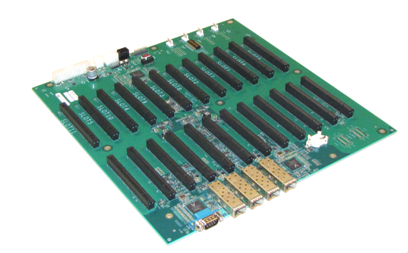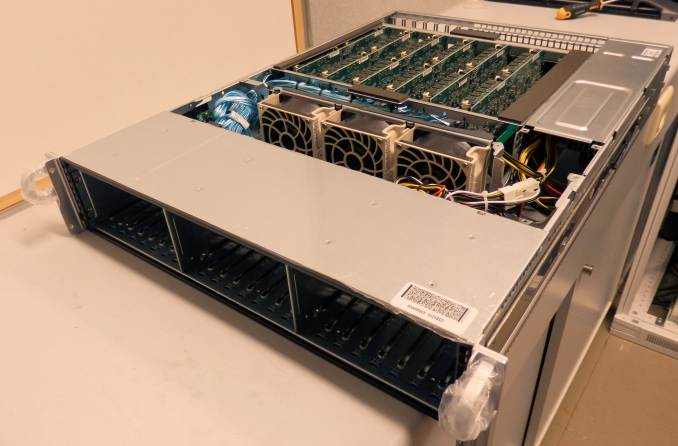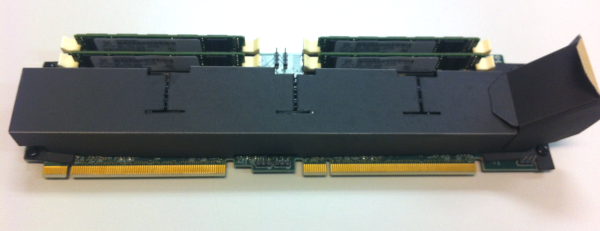Calxeda's ARM server tested
by Johan De Gelas on March 12, 2013 7:14 PM EST- Posted in
- IT Computing
- Arm
- Xeon
- Boston
- Calxeda
- server
- Enterprise CPUs
It's a Cluster, Not a Server
When unpacking our Boston Viridis server, the first thing that stood out is the bright red front panel. That is Boston's way of telling us that we have the "Cloud Appliance" edition. The model with an orange bezel is intended to serve as a NAS appliance, purple stands for "web farm", and blue is more suited for a Hadoop cluster. Another observation is that the chassis looks similar to recent SuperMicro servers; it is indeed a bare bones system filled with Calxeda hardware.
Behind the front panel we find 24 2.5” drive bays, which can be fitted with SATA disks. If we take a look at the back, we can find a standard 750W 80 Plus Gold PSU, a serial port, and four SFP connectors. Those connectors are each capable of 10Gbit speeds, using copper and/or fiber SFP(+) transceivers.
When we open up the chassis, we find somewhat less standard hardware. Mounted on the bottom is what you might call the motherboard, a large, mostly-empty PCB that contains the shared Ethernet components and a number of PCIe slots.

The 10Gb Ethernet Media Access Controller (MAC) is provided on the EnergyCore SoC, but in order to allow every node to communicate via the SFP ports, each node forwards its Ethernet traffic to one of the first four cards (the cards in slots 0-3). These nodes are connected via a XAUI interface to one of the two Vitesse VSC8488 XAUI-to-serial transceivers that in turn control two SFP modules each. Hidden behind an air duct is a Xilinx Spartan-6 FPGA, configured to act as chassis manager.
Each pair of PCIe slots contains what turns this chassis into a server cluster: an EnergyCard (EC). Each EnergyCard contains four SoCs, each with one DIMM slot. An EnergyCard contains thus four server nodes, with each node running on a quad-core ARM CPU.
The chassis can hold as many as 12 EnergyCards, so currently up to 48 server nodes. That limit is only imposed by physical space constraints, as the fabric supports up to 4096 nodes, leaving the potential for significant expansion if Calxeda maintains backwards compatibility with their existing ECs.
The system we received can only hold 6 ECs; one EnergyCard slot is lost because of the SATA cabling, giving us six ECs with four server nodes each, or 24 server nodes in total. Some creative effort has been made to provide air baffles that direct the air through the heat sinks on the ARM chips.
The air baffles are made of a finicky plastic-coated paper, glued to gether and placed on the EC with plastic nails, making it difficult to remove them from an EC by hand. Each EC can be freely placed on the motherboard, with the exception of the Slot 0 card that needs a smaller baffle.
Every EnergyCard is thus fitted with four EnergyCore SoCs, each having access to one miniDIMM slot and four SATA connectors. In our configuration each miniDIMM slot was populated with a Netlist 4GB low-voltage (1.35V instead of 1.5V) ECC PC3L-10600W-9-10-ZZ DIMM. Every SoC provided was hooked up to a Samsung 256GB SSD (MZ7PC256HAFU, comparable to Samsung’s 310 Series consumer SSDs), filling up every disk slot in the chassis. We removed those SSDs and used our iSCSI SAN to boot the server nodes. This way it was easier to compare the system's power consumption with other servers.
Previous EC versions had a microSD slot per node at the back, but in our version it has been removed. The cards are topology-agnostic; each node is able to determine where it is placed. This enables you to address and manage nodes based on their position in the system.














99 Comments
View All Comments
kfreund - Friday, March 15, 2013 - link
Keep in mind that this is VERY early in the life cycle, and therefore costs are artificially high due to low volumes. Ramp up the volumes, and the prices will come WAY down.wsw1982 - Wednesday, April 3, 2013 - link
Ja, IF they have high volume. But even if there is high volume, it's shared between different ARM suppliers and needless to say, the ATOM. How much can it be for one company?But the question is where the ARM get the volume? less performance, comparable power consumption, less performance/watt rational (not this kind extreme bias case ), less flexibility, less software support (stability), vendor specific (you can build a normal server, but can you build up a massive parallel cluster?), oh, don't forgot, more (much more) expensive. Which company will sacrifice themselves to beef up the market volume of the ARM server?
Sputnik_b - Thursday, March 14, 2013 - link
Hi Johan,Nice job benchmarking and analyzing the results. Our group at EPFL has recently done some work aimed at understanding the demands that scale-out workloads, such as web serving, place on processor architectures. Our findings very much agree with your benchmark conclusions for the Xeon/Calxeda pair. However, a key result of our work was that many-core processors (with dozens of simple cores per chip) are the sweet spot with regard to performance per TCO dollar. I encourage you to take a look at our work -- http://parsa.epfl.ch/~grot/pubs/SOP-TCO_IEEEMicro....
Please consider benchmarking a Tilera system to round-out your evaluation.
Best regards!
Sputnik_b - Thursday, March 14, 2013 - link
Sorry, bad URL in the post above. This should work: http://parsa.epfl.ch/~grot/pubs/SOP-TCO_IEEEMicro....aryonoco - Friday, March 15, 2013 - link
LWN.net has a very interesting write-up on a talk given by Facebook's Director of Capacity Engineering & Analysis on the future of ARM servers and how they see ARM servers fit in with their operation. I think it gives valuable insight on this topic.http://lwn.net/SubscriberLink/542518/bb5d5d3498359... (free link)
phoenix_rizzen - Friday, March 15, 2013 - link
ARM already has hardware virtualisation extensions. Linux-KVM has already been ported over to support it.Andys - Saturday, March 16, 2013 - link
Great article, finally good to see some realistic benchmarks run on the new ARM platform.But I feel that you screwed up in one regard: You should have tested the top Xoen CPU also - the E5-2690.
As you know from your own previous articles, Intel's top CPUs are also the most power efficient under full load, and the price would still be cheaper than the full loaded Calxeda box anyway.
an3000 - Monday, March 25, 2013 - link
It is a test using wrong software stack. Yes, I am not afraid to say that! Apache will never be used on such ARM servers. They are exact match for Memcached or Nginx or another set-get type services, like static data serving. Using Apache or LAMP stack is too much favorable for Xeon.What I would like to see is: Xeon server with max RAM non-virtualized running 4-8 (similar to core count) instances of Memcached/Nginx/lighttpd vs cluster of ARM cores doing the same light task. Measure performance and power usage.
wsw1982 - Wednesday, April 3, 2013 - link
My suggestion will be let them run one hard-disk to one hard-disk copy and measure the power usage:)